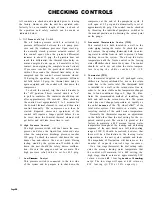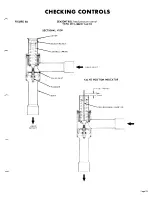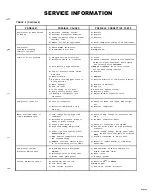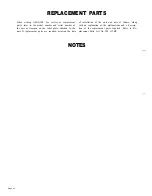
C.
D.
E.
F.
G.
OPERATION
Turn off the water circulating pump. (Water circu-
lating pump often is left on the line as an assist
against damage by freezing of water, if cooler is
not going to be drained).
Turn off the power to the compressor(s), condenser
fan motors, crankcase heaters, and water circu-
lating pump.
Be sure that the cooler section, and all outside
piping is properly protected from freezing
down to
minus 20F.
However, it is advisable to drain the
cooler and all external piping for additional protec-
tion against extended power failure, or possible
electrical component failure.
Close the suction and discharge shut-off valves.
Tag all opened disconnect switches warning
against
starting up the compressor before properly re-open-
ing the shut-off valves.
START-UP AFTER EXTENDED SHUTDOWN
A.
B.
C.
D.
E.
F.
G.
H.
I.
J .
K.
Inspect all equipment.
Check surface of the condenser coil for paper or
other obstruction.
Open the suction and discharge service valves.
Check circuit breakers; must be in “off’ position.
Turn on the electric power to the system.
Open the liquid line shut-off valve(s).
Check crankcase heaters and crankcase warmth.
Start the water circulating pump.
T h r o w pumpdown switches to “man” position.
Start the unit (S1 and circuit breakers on, and
thermostat TCl calling for cooling).
T h r o w pumpdown s w i t c h e s to “auto”
for restart
and
normal operation.
L. After the unit has run for several minutes, check
the oil level in the crankcase. and observe flow
through the refrigerant sight glass for sufficient
refrigerant charge.
IMPEDANCE RELAY OVERLOAD PROTECTION
In
order to provide reset of the unit from the con-
ditioned space or at the unit, an impedance relay
is incorporated in the control circuit. Basically. this
type of control is centered around a relay with a
high impedance holding coil connected in series with
the basic relays and contactors, but also in parallel
with the automatic safety reset control or controls.
The impedance relay normally closed contacts are lo-
cated in the safety control circuit. A normally open
reset button installed at the panel or remotely is con-
nected in parallel with the relay contacts.
For typical operation. refer to Diagram 3, Pages 14
and 15. Note that coil of the impedance relay R 5 is in
series with the group of controls Ml, M3, and R3. T h e
coil is also in parallel with the high pressure control
HP1 and the normally closed relay contacts R5. In
normal operation, HP1 and R 5 are closed and, there-
f o r e there is no voltage across relay coil R5. However,
when t h e system goes out on high head pressure, con-
trol HP1 opens: R5 coil is now in series with the group
of c o n t r o l s Ml, M 3 and R5. Although the relay coil R5
is in series with the group of controls. there is suffi-
c i e n t voltage across it to open the normally closed
contact R5. When the high pressure control HP1 c l o s e s
again
on reduction in head pressure, t he normally
c l o s e d contact R5 is still held open by voltage across
coil R5.
It is. therefore, necessary to push reset switch S 5
to jumper contact R 5 and drop out the impedance relay
so that the system can start. A remote reset switch in
parallel with S5 may B
e
installed for remotely restart-
ing the unit.
Where compressors have external overload protec-
tion. both the HPC and the external overload control
circuit is reset by the impedance circuit. Where com-
pressors have internal overload protection. automatic
r e s e t , o n l y t h e HPC outage i s r e s e t by t h e i m r e d a n c e
circuit
Papa












































